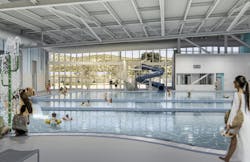10 ways public aquatic centers and recreation centers benefit community health
Note: This blog post recaps some of the findings from HMC's "Aquatic Centers: Bringing Life to Communities" report. Download the free report (short registration required).
Decreased risk of chronic illness. Improved health for people with diabetes and heart disease. Boosted mood and mental health.
According to the Centers for Disease Control and Prevention (CDC), swimming and water-based exercise can benefit everyone and are among the most popular fitness activities in the U.S.
But for many without access to natural water or a swimming pool, water fitness is a luxury only enjoyed by members of private clubs. Even in California, with miles of dreamy coastline, a Mediterranean climate, and swaying palm trees, access to water-based recreation, swim lessons, and health and wellness benefits are just a fantasy to many across the state.
WORKING TOWARD WELLNESS EQUITY
According to the National Institutes of Health, health equity is the state in which everyone can attain full health potential, and no one is disadvantaged from achieving this potential because of social position or any other socially defined circumstance.
Community aquatic facilities are vital in filling this gap and creating a more equitable future for people in diverse neighborhoods where significant space, economic, or climate challenges limit swimming pool access.
Investing in new facilities that nurture public health and well-being seems like a given. After all, the scientific community has clearly established the benefits of physical activity for educational outcomes and illness prevention. Public aquatic facilities provide multi-generational benefits in health, wellness, water safety training, and recreational access.
BREATHING LIFE INTO THE COMMUNITY
Public aquatic programs support and benefit the communities that host them in a myriad of ways:
1. These programs provide multigenerational health and wellness offerings to the community (swim lessons, summer camps, serving as cooling centers, senior fitness/water aerobics classes, and swimming as fitness training).
2. Water safety programs help save lives. According to the CDC, there are strong racial and economic disparities in access to these programs and the risk of death by drowning. Creating more public facilities can help address disparities in private aquatics availability and improve access equity.
3. Aquatics programs allow the community to come together for play, competition, fitness and learning at all ages.
4. Community swim programs at educational facilities create a stronger relationship with the host community, increasing access, public engagement, and recruitment into higher education opportunities.
BENEFITS OF THOUGHTFUL DESIGN FOR AQUATICS CENTERS
A well-considered design can mitigate many hurdles to creating these facilities in more challenging locations and climates:
1. A thoughtful approach can establish a deeply contextual relationship between the facility’s architecture and the community that considers it a part of their home, raise public awareness and engagement, and elevate public aquatics programs to become a source of civic pride.
2. Creating an experience that feels like it belongs in your neighborhood is the key to a durable and successful facility.
3. Every location is unique. Next-door neighbors, historical relationships, climatic conditions, and economic factors all shape a truly contextual design.
4. Connection to context creates a facility that enhances the community rather than being seen as a nuisance (overcoming NIMBYism). Your facility should speak to who you are and feel a part of the landscape and town in which it resides.
5. One size does not fit all. Some facilities may require an iconic presence in the landscape, others may respond to adjacent architectural precedents, and others may need to be discrete members of a quiet neighborhood. Often one project may need to do all these things, depending on which side of the site you are approaching from.
6. An indoor natatorium may make more sense in some locations by allowing greatly extended operating hours and seasons (Remember: not all of California is a coastal community).
Note: This blog post recaps some of the findings from HMC's "Aquatic Centers: Bringing Life to Communities" report. Download the free report (short registration required).
About the Author
HMC Architects
We’re problem solvers at heart. HMC Architects is a healthcare, education, and civic architecture firm with a sustainable approach to design. Our passionate and empowered teams truly love their work, and it shows. Learn about our partnerships with healthcare, education, and civic clients and see how we’ve worked together to solve their toughest design problems. Check out our new COVID research papers on our Research site. Follow us on Facebook, Instagram, LinkedIn, Twitter, and Vimeo.
